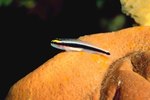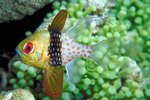
Small, perky, brightly colored -- these traits have made the clownfish a staple addition for reef tank aquarists. The clownfish is a type of damselfish belonging to the subfamily Amphiprioninae, which contains 28 species classified into two genera. In captivity, the clownfish requires typical Pacific reef tank parameters. Water quality must be exceptional if the clownfish is paired with a finicky sea anemone.
Maintaining Water Quality for Good Health
A captive clownfish requires the same water conditions as the anemone with which it bonds. Water temperatures should be in the high 70s Fahrenheit; specific gravity should be 1.023 and pH 8 to 8.4. Metabolite levels should be low. Your clownfish needs biofiltration, protein skimming and frequent water changes to stay healthy. Unfortunately, the clownfish is susceptible to disease, especially when introduced to a new aquarium. Cryptocaryon irritans and Brooklynella hostilis are common parasites that afflict the clownfish. Even after successful introduction, your clownfish needs constant water maintenance to prevent illness. Often you can cure a sick fish simply by transferring him to a hospital tank until his health has improved to normal.
Feeding and Behavior
In the wild the clownfish eats zooplankton and algae. In captivity you can feed it just about any dried, prepared, frozen or fresh marine fish foods with a mix of animal and vegetable matter. Your clownfish will share his food with his symbiotic anemone. Your clown will most likely be aggressively territorial, especially when he comes to protecting his invertebrate partner. A new clownfish should be introduced to an already populated aquarium. If you need to add new fish after the clownfish is established, you can try rearranging the aquarium or slightly overfeeding the clownfish for a short time to lessen its territoriality. A male/female clownfish pairing works well, but any other combination is not advisable -- the fish will fight each other. If you listen closely you can hear your clownfish making clicking and grunting sounds as a form of communication.
Adding an Anemone
You can recreate the clownfish-anemone bond in your home aquarium. Your anemone will require the same water quality as the clownfish and will also demand very bright lighting. The best possible option for housing both animals is to buy an anemone and a clownfish who are already paired to each other. A captive-bred clownfish doesn't necessarily require an anemone, but often a wild-caught specimen will fare significantly better if provided with an anemone. Some species do better than others without anemones, for example Amphiprion melanopus, A. frenatus and Premnas biaculeatus. If choosing to include an anemone in your tank, choose a Pacific Ocean species, because the clownfish also hails from these seas. There is a chance your anemone and clownfish won't take to each other. The anemone may even eat the clownfish.
Other Suitable Tank Mates for Clowns
The clownfish originates from tropical Pacific Ocean reefs and does well with fish and invertebrates from that same environment. As long as you introduce him appropriately, your clownfish can get along with many reef fish. A few examples include angelfish, basslets, blennies, cardinals, gobies, pseudocrhomis, puffers and tangs. Your clownfish will definitely fare well with coral and live rock, as well as invertebrates other than his host anemone. Anglers, triggers and wrasses can get along with your clownfish, but pair them with caution. Drumfish, eels, groupers, lionfish, sharks and rays grow big enough to eat your clown; don't make him share a habitat with any of them.
References
Resources
Photo Credits
-
Jupiterimages/Photos.com/Getty Images
Writer Bio
Madeline Masters works as a dog walker and professional writer. In the past she has worked as a fitness columnist, fundraising copywriter and news reporter. Masters won two Pennsylvania Newspaper Association Awards in 2009. She graduated from Elizabethtown College with a Bachelor of Arts in English.




